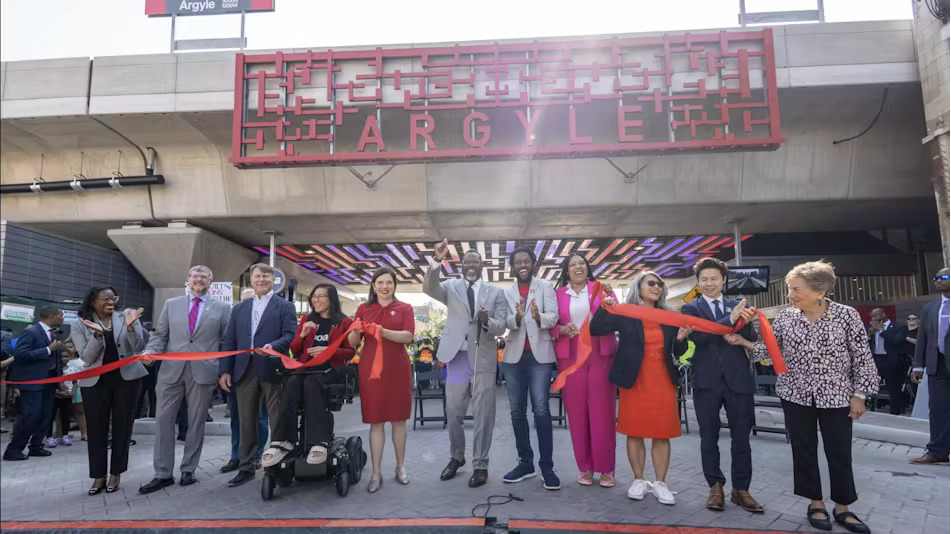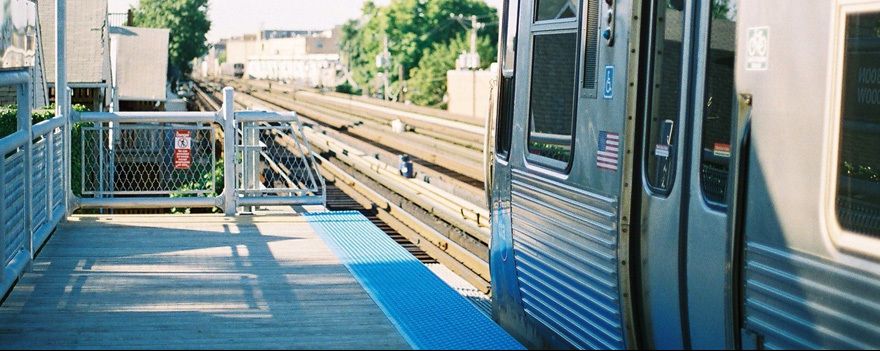About
Learn about Chicago Transit Authority including our ESG Program, News & Press Releases, Projects, and Team.
Talk to us
Have questions? Reach out to us directly.
Learn about Chicago Transit Authority including our ESG Program, News & Press Releases, Projects, and Team.
About Chicago Transit Authority
- Ridership as of 2024
- 309.2 Million
- Debt Obligations as of 9/1/22
- $4,928,230,402
- FY2024 Operating Budget
- $1.99 Billion
Organization
Chicago Transit Authority is an independent governmental agency created by state legislation. CTA began operating on Oct. 1, 1947, after it acquired the properties of the Chicago Rapid Transit Company and the Chicago Surface Lines. On Oct. 1, 1952, CTA became the predominant operator of Chicago transit when it purchased the Chicago Motor Coach system.
Governance & Oversight
The governing arm of the CTA is the Chicago Transit Board. The Board consists of seven members, with four appointed by the Mayor of Chicago and three appointed by the Governor of Illinois.
The Mayor's appointees are subject to the approval of the Governor and the Chicago City Council; the Governor's appointees are subject to the approval of the Mayor and the Illinois State Senate. CTA's day-to-day operations are directed by Dorval R. Carter, Jr., President.
The current Mayoral appointees are Lester L. Barclay, Alejandro Silva, Michele A. Lee and Rev. Johnny L. Miller. The current gubernatorial appointees are Rev. Dr. L. Bernard Jakes and Rosa Y. Ortiz. There is one gubernatorial vacancy.
Lester L. Barclay serves as Chairman of the Chicago Transit Board.
CTA generates revenue from both farebox collections and nonfarebox revenues, and also receives supplemental funding for operating expenses through the Regional Transportation Authority (RTA).
The RTA was established in 1974 to oversee local transportation operators in the six-county Chicago metropolitan area. Illinois state law requires the three RTA service boards— CTA, Metra (the suburban rail system) and Pace (the suburban bus system) — to recover collectively at least 50 percent of operating costs from farebox and other system revenues.
Service Overview
The Chicago Transit Authority (CTA) operates the nation’s second largest public transportation system, providing mass transit services within the City of Chicago and 35 surrounding suburbs. The service area of the CTA has a population of approximately 3.2 million. Historically, the CTA has carried over 81 percent of the public transit riders in the six-county northeastern Illinois region, which includes the Counties of Cook, DuPage, Kane, Lake, Mchenry, and Will. Transit services provided by the CTA are part of the regional public mass transportation service system in the Northeastern Illinois Transit Region provided through the independent operations of the CTA, the Commuter Rail Division ("Metra") of the Regional Transportation Authority (the "RTA"), and the Suburban Bus Division ("Pace") of the RTA (the CTA, Metra, and Pace).
Strategic Goals
Considering the mission statement and core values, the CTA created three overarching goals, which were applicable in the past and will continue to be so in the present and future.
- Safety – CTA aims to ensure that customers and employees have a safe and secure transit system and workplace that prioritizes safety over all aspects of service delivery
- Customer Experience – CTA places a high priority on putting the customer at the center of every decision made and action taken to ensure its services meet or exceed customer expectations
- Workforce Development – CTA invests in its workforce to build on past successes and works toward a bright future creating job and learning opportunities with a focus on Diversity, Equity and Inclusion (DEI)
Image Gallery
ESG Program
Learn about our environmental, social, and governance program, and how we bring those values to life with green bonds, sustainable projects, and more.
News
News
November 14, 2025
A new era has begun for transit in the Chicago region. In the early morning hours of October 31, the Illinois General Assembly passed SB 2111, a landmark transit funding and reform bill. The legislation includes an estimated $1.2 billion in new annual operating funding for CTA, Metra, and Pace. This sustainable funding means riders will not experience service cuts or fare increases in 2026 and instead will benefit from continued improvements to service frequency, reliability, and safety in the coming years.
The bill reorganizes the transit system under a new regional authority, the Northern Illinois Transit Authority (NITA), replacing the RTA and taking on new responsibilities including setting fares, enhancing and coordinating service, overseeing long-term capital planning, and leading implementation of unified rider-focused tools such as more seamless mobile ticketing.
NITA’s board will include 20 members with 5 members appointed by the Governor, 5 by the Mayor of Chicago, 5 by the Cook County Board President, and 5 by the Collar County Board Chairs. Starting in 2027, after funding NITA expenses, ADA paratransit, and baseline funding for the Service Boards, remaining operating funding will be distributed to CTA, Metra, and Pace using a new formula that includes key performance-based metrics from the National Transit Database (NTD) and will later transition to distribution via a soon-to-be-developed service standards model that will help guide appropriate levels of service for different communities.
Where does the new funding come from?
The legislation identifies a variety of new revenue streams for transit operations.
- Dedicating existing sales tax on motor fuel: $860 million statewide ($731 million for RTA region and $129 million for downstate transit)
- RTA sales tax increase of 0.25%: $478 million for RTA region, pending approval by the RTA Board after the legislation’s effective date of June 1, 2026.
- New capital revenue from interest on the Road Fund balance: $200 million statewide ($180 million for RTA region and $20 million for downstate transit)
Simplified fare policy and purchasing with no fare increase in 2026
The legislation requires no fare increases for 2026. In the future, instead of each Service Board offering different reduced fares, NITA will have sole authority over all special fare programs for the entire regional transit system. And in 2028, NITA will implement several new fare programs, including fare capping, income-based reduced fare programs, and free and reduced fare programs for survivors of domestic violence and sexual assault.
In addition to setting all fare policy for the regional transit system, NITA will also be responsible for rolling out a unified fare collection system including a mobile ticket app by February 2030.
Improved frequency and reliability through service planning and standards
Beginning in December 2027, NITA will work with the Service Boards to develop a 1-3-year service plan with opportunities for public feedback. The service plan will aim to optimize the location, frequency, and days and hours of service and will address issues like reliability, cleanliness, safety, and coordination among CTA, Metra, and Pace.
The service plan must be consistent with new service standards adopted by the NITA Board that will help determine appropriate levels of service for different communities. These standards will be developed cooperatively between NITA and the Service Boards and will look to peer systems around the world to inform qualitative and quantitative attributes of good public transit. Once the service standards are implemented, NITA will meet with the Service Boards quarterly to ensure operations are continuing effectively and to address any issues related to the standards. NITA will also compile and publish reports comparing actual system performance to service standards. This reform empowers the regional authority to formally weigh in on service issues more regularly and prevent long-term service disruptions.
A safer, more secure system
The legislation requires NITA to develop various new staff positions, task forces, councils, and subcommittees in collaboration with law enforcement agencies throughout the region, as well as riders, social service agencies, and other public safety experts. The NITA Board will ultimately vote on whether to institute a sworn officer crime prevention program and will institute a transit ambassador program by July 2027. Transit ambassadors are trained, unarmed personnel deployed on buses and trains and at stops and stations to support riders. Responsibilities may include wayfinding and other passenger assistance and helping address safety concerns.
Learn more
SB 2111 is landmark legislation that establishes a new regional entity, with changes to board structure, recovery ratio requirements, funding distribution to the Service Boards, advisory councils, the budget process, transit-supportive development, and more. For more details on these changes and how the transition will occur, read RTA’s preliminary bill summary.
News
July 22, 2025
The new, larger stations replace ones that were over 100 years old, bringing updated amenities to Chicago transit users.

Four renovated rail stations reopened July 20 along the Chicago Transit Authority’s (CTA) Red Line. The renovations to make the Lawrence, Argyle, Berwyn and Bryn Mawr stations fully accessible are part of the $2.1 billion Red and Purple Modernization (RPM) Phase One Project.
In addition to ADA compliance, including escalators, elevators and wider platforms, CTA customers will experience the following amenities at the updated stations:
- Larger stations replace the previous ones that were more than 100 years old.
- Better lighting and security features.
- Real-time information boards.
- Smoother, more reliable train service.
- Decrease in overcrowding on trains and platforms.
- A brighter, cleaner and more aesthetically pleasing pedestrian environment.
- Original artwork at each station.
CTA notes the RPM Phase One is the largest completed transit investment in agency history, and the opening of four new contiguous stations marks the first time this many stations have opened simultaneously since the Orange Line in 1993.
“It was wonderful to welcome CTA riders today to our brand new, fully accessible Red Line stations and to showcase the RPM team’s hard work to modernize and improve rail service for the people who visit, live in and work in these communities,” said CTA Acting President Nora Leerhsen. “I am grateful to the people in the neighborhoods that these stations will serve— including the residents, businesses and local elected officials that have partnered with us during construction—for their support. Now is the time to celebrate together the access and opportunity that these new, breathtaking stations will provide.”
Public space under the ‘L’ tracks
With the completion of track and station construction, CTA says it will continue with some final finishing construction work and be substantially done with RPM Phase One by the end of 2025, with the exception of upcoming development of newly created spaces under the ‘L’.
- CTA plans to develop 10 blocks of open space located under the new Red and Purple line tracks between Lawrence and Ardmore avenues based on input from the community.
- The open space design plans include a pedestrian trail, dog parks, playground, fitness area, benches and flexible-use plaza space for community events.
- Construction is expected to begin in 2026 and be completed in 2027.
The Red Line and RPM
The CTA’s Red Line is CTA’s busiest rail line, providing nearly 40 million rides in 2024. CTA is completing Phase One of the multi-phase RPM Program, which is rebuilding the 9.6-mile stretch of Red and Purple line track structure and stations on the North Side that were a century old. RPM replaces aging infrastructure; increases CTA’s capacity to increase train service as needed; and improves service for customers with more reliable, comfortable service.
News
February 7, 2025
The Driving a Cleaner Illinois – Volkswagen award is the largest grant to date from the Illinois Environmental Protection Agency
MARKHAM, IL, FEB. 7 – Earlier today, Governor JB Pritzker and the Illinois Environmental Protection Agency (IEPA) joined Pace and the Regional Transportation Authority (RTA) at Pace’s new state-of-the-art Markham Campus Bus Acceptance Facility to celebrate a $27 million award to Pace for the purchase of electric buses and $31.25 million to the RTA (for the Chicago Transit Authority) through “Driving a Cleaner Illinois.” The Driving a Cleaner Illinois – Volkswagen grant opportunity for electric buses to the RTA region are the largest grants that IEPA has announced from the program to date; the previous high was $14 million.
Pace will provide a $9 million match and the RTA will provide a $10.42 million match to the IEPA award. Pace will purchase 27 battery-electric buses (BEBs), and the Chicago Transit Authority (CTA) will purchase 30-all-electric transit buses to replace the oldest diesel buses in their fleets.
Honored speakers included Governor JB Pritzker, State Senator Napoleon Harris, Markham Mayor Roger Agpawa, IEPA Acting Director James Jennings, RTA Chairman Kirk Dillard, Pace Chairman Rick Kwasneski, and Pace Executive Director Melinda Metzger.
Other guests included State Representative Bob Rita, State Representative Matt Hanson, IDOT Acting Secretary Gia Biagi, Cook County Commissioner Donna Miller, Cook County Commissioner Dr. Kisha E McCaskill, University Park Mayor Joseph Roudez III, and representatives from U.S. Senator Tammy Duckworth’s Office, U.S. Congresswoman Robin Kelly’s office, State Senator Kyle Hasting’s office, the Village of Robbins, South Suburban Mayors & Managers Association, Chicago Southland Economic Development Council, and South Suburban College.
By transitioning to a zero-emission fleet, our region’s public transportation system aims to significantly reduce harmful pollutants, contributing to healthier communities and a greener future. Pace Chairman Rick Kwasneski welcomed guests and said, “Public transit is more than just buses — it’s about connecting people to jobs, schools, healthcare, and opportunity, and being a good steward of our environment. We are grateful to the Governor’s leadership, which ensures critical, clean energy initiatives move forward."
“Illinoisans of all backgrounds depend on Pace and the CTA. Whether commuting to work, visiting friends and family, or running their everyday errands — the convenience and efficiency of these systems is absolutely essential to their everyday lives,” said Governor JB Pritzker. “Pace has added 27 new, fully electric buses – along with 30 that will join the CTA fleet. This is an investment that will help us meet our climate goals, create opportunity for our people, and further connect our communities. Electric buses are vital to the future of transit — clean, reliable, and convenient — and I’m excited to be taking a step toward that future today.”
“Transit is the strongest tool we have in the fight against climate change, and we are grateful for the partnership of the IEPA in leading that fight,” said RTA Board Chair Kirk Dillard. “This investment will improve service and provide cleaner air for Pace and CTA riders in the short term and in the long-term, help us lower greenhouse gas emissions.
“RTA is committed to leading regional grant applications in the future to advance key transit capital priorities for our region,” Dillard continued. “This award from IEPA takes us another step further in meeting our regional commitment of reaching a zero-emissions bus fleet by 2040.”
Driving a Cleaner Illinois is the IEPA’s grant program developed to distribute funding for various types of mobile source electrification projects. The Driving a Cleaner Illinois Program implements funding from a variety of sources, including the Climate and Equitable Jobs Act, the Volkswagen Environmental Mitigation Trust, and U.S. Environmental Protection Agency’s Diesel Emission Reduction Act (DERA) Program.
“We are thrilled to see this state investment in transit that will allow us to make even greater strides toward our vision of a zero-emission system,” said RTA Executive Director Leanne Redden. “This award not only allows the CTA to make significant progress on greening its bus fleet, but it also helps to enhance service and reliability for all bus riders.”
Grant awards from IEPA to RTA and Pace will be incorporated into the RTA 5-Year Regional Capital Program later this year and future service board bus purchasing plans will incorporate these grants to receive new electric buses in the near future.
“We are grateful to the IEPA and RTA for helping CTA to advance our goal of converting to an all-electric bus fleet — a complex and challenging undertaking that includes replacing 1,800 buses and making the upgrades and capital investments necessary to support them,” said Acting CTA President Nora Leerhsen. “These grant funds will make a significant contribution towards a greener future for CTA as we move ahead with ‘Charging Forward: CTA’s Bus Electrification Planning Report’ — the first-ever roadmap for the full electrification of our entire bus fleet.”
The Illinois EPA has been designated as the lead agency to administer funds allocated to Illinois from the Volkswagen Environmental Mitigation Trust. Illinois’ initial allocation of funds is approximately $108 million to be used to fund mobile source diesel emission reduction projects. The funds are to be used for projects that reduce emissions of nitrogen oxides in Illinois.
“Emissions from diesel powered transit buses negatively impact air quality in the communities they serve and the region as a whole,” said Illinois EPA Acting Director James Jennings. “Through the VW settlement funding and additional cost-sharing commitments from both Pace and RTA/CTA, these projects represent a $77 million investment in clean transportation that will benefit communities throughout the Chicago area.”
“This investment will provide climate-friendly transit options that improve mobility and quality of life for people across the region,” said Acting Illinois Transportation Secretary Gia Biagi. “Under Governor Pritzker’s leadership, we are working closely with our transit partners to make our entire transportation system safe, reliable, and green.”
“It's refreshing to see how something that began as a challenge for Volkswagen has been turned into a positive force for change, furthering both our region’s and the state’s pollution reduction goals. This transformation underscores the real impact of investing in clean transportation solutions,” said Pace Executive Director Melinda Metzger.
Projects
View All Projects
Team

Nora Leerhsen
Acting President
nleerhsen@transitchicago.comView Bio

Tom McKone
Chief Financial Officer
tmckone@transitchicago.comView Bio
Talk to us
Have questions? Reach out to us directly.





